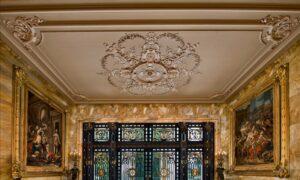Overshadowed by Sacramento’s skyscrapers, the Leland Stanford Mansion is a stunning example of the splendor of the Victorian era in the California capital. “Magnificent and costly furniture in every room; lace curtains of the finest fabric; … frescoes beautiful in design and exquisite in artistic perfection, adorn the walls and ceiling” wrote the San Francisco Chronicle about the 44-room manor over 150 years ago.
Central Pacific Railroad president Leland Stanford purchased the four-year-old home for $8,000 in 1861—just before he became governor. A decade later, he and his wife Jane had the residence remodeled to reflect their new wealth and social status. In response to frequent flooding of the Sacramento River, Stanford had the house raised 12 feet after he had captained a rowboat from a second story window to his gubernatorial inauguration.

A level was added to both the bottom and top of the two-story house, expanding it from 4,000 square feet to 19,000 square feet. It was redesigned to reflect Second Empire, also called Napoleon III, architecture that was a decorative revival style in vogue during the latter half of the 19th century.
Adapting eclectic elements from different historic periods, such as Italian Renaissance, French Renaissance, and Palladian, the design managed to give them coherence and harmony. The manor’s mansard roof popularized by the French Baroque architect Francois Mansart slopes downward on all sides of the structure, maximizing the interior space.
On Feb. 6, 1872, the couple celebrated the reopening of their home by inviting 700 starched-collared gentlemen and tightly corseted ladies to an elaborate dinner party and fancy-dress ball the Sacramento Union described as “brilliantly dazzling.”

Manor Grandeur

Guests drove up in handsome horse-drawn carriages to the stylish brick mansion fashioned with rich embellishments of overhanging eaves, heavily bracketed cornices, whimsical crowns above the windows, and cast iron cresting on the roof. They ascended the grand baroque staircase to the central pavilion with ornate ionic columns before stepping into the arched entryway.
An immaculately groomed butler formally escorted them into the receiving parlor, where they were introduced to each other before dinner. It’s the oldest and most formal room in the house with the 1857 gilded mirrors, crystal chandeliers, and ceiling medallions. An 1850 photograph shows Leland Stanford at age 26 and Jane Lathrop at age 22 when they were married.

The formal dining room contains furnishings that reflect Stanford’s connection with the railroad. The round top walnut dining table—which extends to fit 10 leaves—has burl panels on the skirt and four sturdy bracket legs ending in prominent finials that look like miniature steam locomotives. The gentlemen’s parlor and library is entered through pocket doors at the back of the room.



Off the dining area, the music room opens to the ladies’ parlor that was also used as a lesser parlor for uninvited visitors. Rosewood chairs on either side of the mirror console are Rococo Revival with decorative carvings on the crest rail. The rosewood, walnut, and birdseye maple sideboard has a triple-tiered étagère—set of open shelves designed to display small objects or ornaments. A crystal goldfish bowl sits on a stand between a pair of revival armchairs.

The recreated draperies for the 17-foot-ceiling rooms are based on historical photographs of the mansion in 1872. The window coverings reflect the Victorian Age with large cornice boxes and valances in the music and sitting rooms, edged with scroll braid and macaroons. Reflecting the color palette of the house—which is terra cotta, light gold, sage green, claret red, and pale blue—Tinka Davi, a former special sections editor for the Sacramento Bee, described the draperies as “peaceful, rich, and subdued.”

The centerpiece of Jane’s elegantly furnished third-floor bedroom is the Renaissance Revival rosewood, walnut, and Brazilian wood bed with a high-arched headboard and large cartouche crest. She gave birth in the bed to their only child, Leland Jr., in whose memory they cofounded Leland Stanford Junior University.

Last Waltz
“The music swelled with its voluptuous cadence, and despite (ladies’) long trains, the guests engaged in the maddening, entrancing waltz, or in the stately, measured ‘Lancers’ (Quadrille),” observed the San Francisco Chronicle at the 1872 party. Catching their breath between whirls in the large ground-floor ballroom, some dancers conjugated around the hat and umbrella hallstand, and sat on the two flanking chairs with seats that open to a small hiding space.
By 1876, the Stanfords had outgrown Sacramento. They spared no expense in building a luxurious 41,000-square-foot Nob Hill mansion known for its legendary art collection. It was destroyed in the 1906 San Francisco earthquake.
Six years earlier, Jane Stanford, a widow since 1893, generously donated the Sacramento mansion to the city’s Roman Catholic Diocese for the Sisters of Mercy to use as an orphanage. It remained true to the Stanford philanthropic legacy as a home for children in need until 1986.






